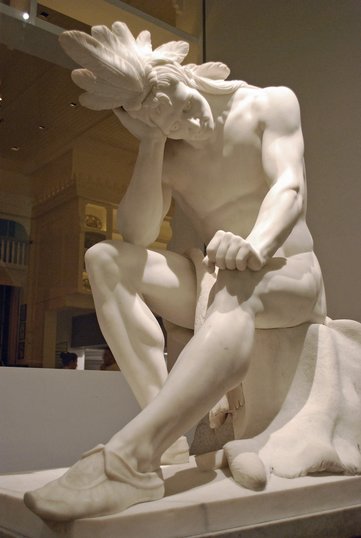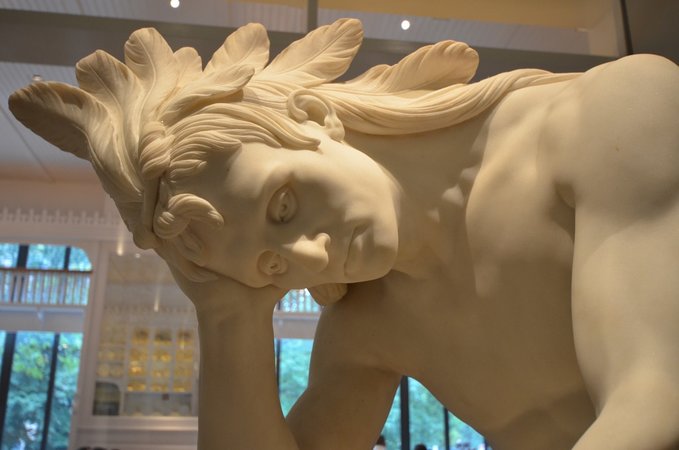March 2017
Molly Peacock
molly@mollypeacock.org
molly@mollypeacock.org
What do I wish for everyone in the world? To be able to lie down and examine their lives with a sympathetic witness behind them.
I had the privilege of examining my life periodically over almost four decades with the woman who was first my therapist, later my analyst. For me, a working class girl, this was an enormous undertaking. Then came the shock of the ambiguous loss of this remarkable woman after her stroke at age 77. Struggling with what the core of a human personality is, we began a strange post-analytic friendship, one in which I had a different privilege: watching her put her life back together through painting. This poem, a riff on a villanelle, takes place at one of the small museums we visited. Her new relationship to art was direct and immediate. The sculpture really became a living entity for her. When she spoke to it, addressing the figure as “you,” my cultural reservations about a white man making a marble white sculpture of a native American as a symbol dropped away. The villanelle-ish form of the poem uses partial repetition to create a semblance of how ambiguous loss (that state when a person is there but not there) feels.
If the spirit moves you, please breeze over to my website: www.mollypeacock.org
I had the privilege of examining my life periodically over almost four decades with the woman who was first my therapist, later my analyst. For me, a working class girl, this was an enormous undertaking. Then came the shock of the ambiguous loss of this remarkable woman after her stroke at age 77. Struggling with what the core of a human personality is, we began a strange post-analytic friendship, one in which I had a different privilege: watching her put her life back together through painting. This poem, a riff on a villanelle, takes place at one of the small museums we visited. Her new relationship to art was direct and immediate. The sculpture really became a living entity for her. When she spoke to it, addressing the figure as “you,” my cultural reservations about a white man making a marble white sculpture of a native American as a symbol dropped away. The villanelle-ish form of the poem uses partial repetition to create a semblance of how ambiguous loss (that state when a person is there but not there) feels.
If the spirit moves you, please breeze over to my website: www.mollypeacock.org
Contemplating Your Progress
Thomas Crawford’s sculpture, 1856
Stroke due to arteriovenus malformation, 2012
The New York Historical Society.
Huge white marble sculpture in the lobby:
“Dying Indian Chief Contemplating
the Progress of Western Civilization.”
You duck beneath him with your wobbly cane
then upturn your face toward his, contemplating
his sober view of hysterical society.
“Something terrible has happened!” you say loudly
as a teenage girl to the sculpted dying man.
“He’s so sad!” you repeat to the empty lobby
where we make a pair, a society of two
(plus a volunteer and a guard) contemplating
the mystery of the new you, brain torqued
from your stroke. You connect without history
—but with feelings whole—to the agony
of the Dying Indian Chief in marble.
Your fresh response remakes his catastrophe.
Yes, something terrible has happened—
we amble on. “That’s a very sad man back there.”
Progress comes. With a cane. Without piety.
Wake up a statue. Then repair.
From The Analyst by Molly Peacock, W.W. Norton and Company, 2017
Thomas Crawford’s sculpture, 1856
Stroke due to arteriovenus malformation, 2012
The New York Historical Society.
Huge white marble sculpture in the lobby:
“Dying Indian Chief Contemplating
the Progress of Western Civilization.”
You duck beneath him with your wobbly cane
then upturn your face toward his, contemplating
his sober view of hysterical society.
“Something terrible has happened!” you say loudly
as a teenage girl to the sculpted dying man.
“He’s so sad!” you repeat to the empty lobby
where we make a pair, a society of two
(plus a volunteer and a guard) contemplating
the mystery of the new you, brain torqued
from your stroke. You connect without history
—but with feelings whole—to the agony
of the Dying Indian Chief in marble.
Your fresh response remakes his catastrophe.
Yes, something terrible has happened—
we amble on. “That’s a very sad man back there.”
Progress comes. With a cane. Without piety.
Wake up a statue. Then repair.
From The Analyst by Molly Peacock, W.W. Norton and Company, 2017
© 2017 Molly Peacock
Editor's Note: If this poem(s) moves you please consider writing to the author (email address above) to tell him or her. You might say what it is about the poem that moves you. Writing to the author is the beginning of community at Verse Virtual. It is very important. -FF


